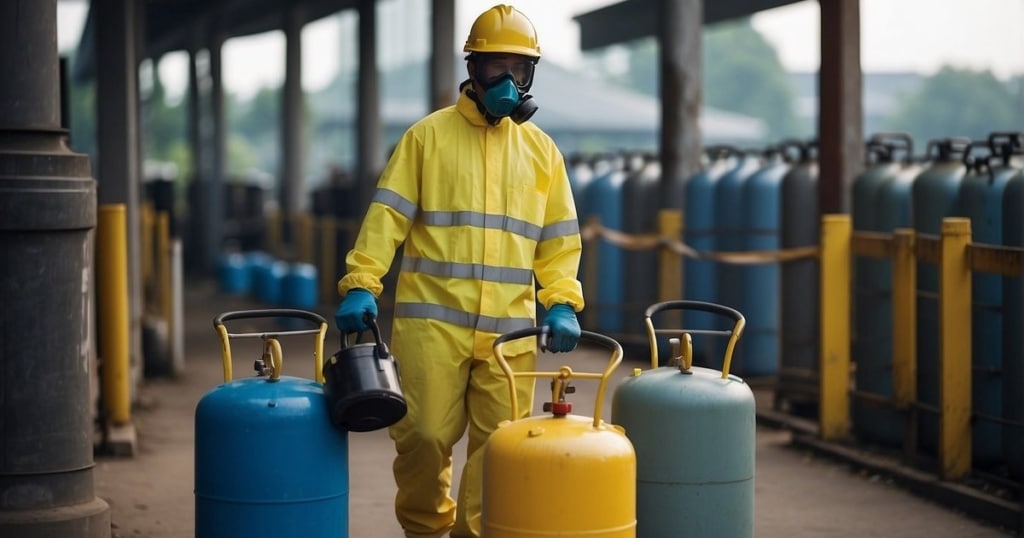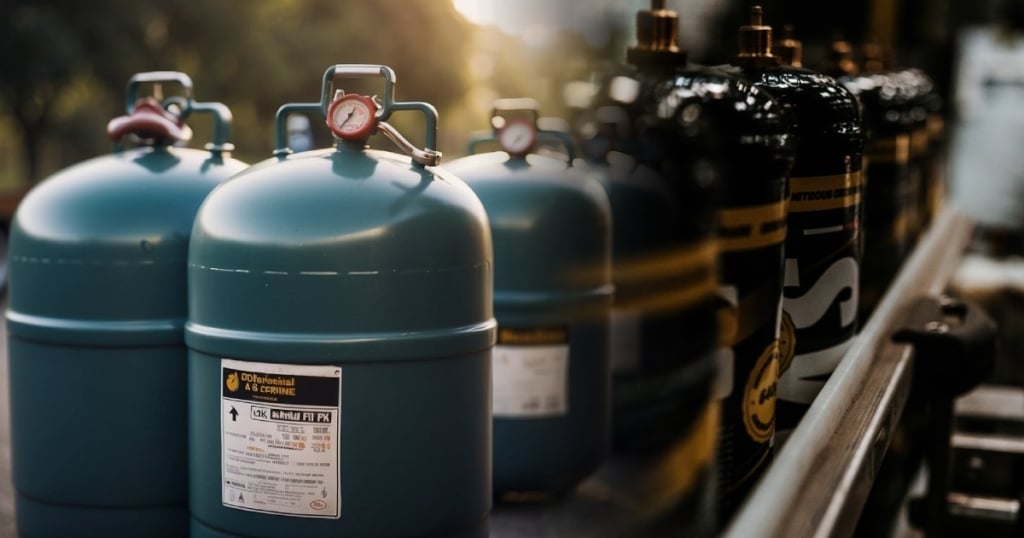Gas Cylinder Safety: Essential Tips for Handling and Storage
FastGas Blog
Gas cylinder safety is paramount when dealing with these high-pressure containers that store various gases for industrial, medical, and domestic use. Proper handling and use of gas cylinders are crucial because misuse can lead to severe injuries, fatalities, or property damage due to fires or explosions. Understanding the risks and adhering to safety protocols is essential. You should always prioritise safety measures, such as ensuring adequate ventilation and restricting cylinder access to trained individuals.
Regarding storage, transport, and disposal, specific standards must be followed to maintain safety. Also, gas cylinders should be stored upright and secured to prevent tipping, away from sources of heat or ignition, and in a well-ventilated area to prevent gas accumulation. Moreover, secure cylinders properly in vehicles to avoid movement, and never dispose of them with regular waste. Professionals should handle the disposal of gas cylinders to ensure environmental safety and compliance with regulations.
Key Takeaways
- Practice strict safety measures when handling gas cylinders.
- Store and transport cylinders securely and in compliance with safety standards.
- Professional disposal of gas cylinders is essential for environmental safety.
Gas Cylinder Handling and Use
Responsible handling and correct use of gas cylinders are critical to ensuring safety in the workplace. Furthermore, familiarise yourself with the fundamentals of gas cylinder operation, embrace appropriate safety measures, including personal protective equipment, and follow strict operational guidelines and comprehensive training.
Basics of Gas Cylinder Use
Always inspect cylinders before use for any signs of defects, leaks, or damage. Also, verify that cylinders are stored upright and secured to prevent tipping. Furthermore, ensure the cylinder contents match your intended application and check that the cylinder is within its inspection date.
Safety Measures and Personal Protective Equipment
Wear protective gloves and safety shoes to shield against potential hazards like propane or acetylene leaks, which can cause frostbite or burns. Eye protection is vital, particularly in welding applications. Moreover, make sure all Personal Protective Equipment (PPE) meets industry standards.
Operational Guidelines and Training
Strictly adhere to operating procedures and regulations, including OSHA and CGA guidelines. Only trained personnel should handle gas cylinders. Adequate training must include lifting techniques to prevent back injury, correct connection/disconnection of valves, and actions to take in case of gas discharge or spills. Always transport cylinders using appropriate equipment to maintain an upright position and avoid damage.
Remember, correct handling and regular maintenance of Fast-Gas cylinders and adherence to safety regulations will ensure their safe use across all industry applications.
Storage, Transportation, and Disposal
When dealing with gas cylinders, understanding the specifics of safe storage, proper transportation, and compliant disposal is crucial. Safety standards are designed to prevent accidents and ensure the integrity of flammable gases like LPG and inert gases like nitrogen and oxygen, which are common in both healthcare and manufacturing.
Storing Gas Cylinders Safely
- Ventilation: Ensure your storage area is well-ventilated. A build-up of gases can lead to dangerous environments.
- Separation: Store flammable gases away from heat and ignition sources, maintaining a good distance to mitigate the risk of explosions.
- Orientation: Gas cylinders should be stored upright and secured with chains or straps to prevent them from falling over.
- Identification: Clearly label each cylinder with its contents to avoid confusion and improper use.
Best Practices:
- Conduct regular risk assessments to address potential hazards.
- Keep the quantity of gas cylinders on-site to the essential minimum.
- Inspect storage areas frequently for compliance with safety regulations.
Transportation Regulations and Equipment
- Regulations: Familiarize yourself with the ADR framework governing the carriage of dangerous goods by road, including gas cylinders.
- Vehicles: Use well-maintained vehicles equipped with proper ventilation to minimise the risk of gas buildup during transport.
- Handling Equipment: Employ trolleys or forklift trucks designed for cylinder transport to prevent accidents and ensure stability.
Safety Equipment:
- Non-sparking tools to avoid ignition sources.
- Wear protective gear when loading and unloading cylinders.
Disposal and Recycling Protocols
- Examination: Perform a periodic assessment of cylinders before disposal to determine their condition.
- Gas Removal: Ensure all flammable and liquefied gases are properly emptied from the cylinder, following protocols to reduce the risk of explosions.
- Recycling: Contact authorised facilities for the recycling or safe disposal of gas cylinders to comply with environmental regulations.
Cylinder Repair:
- Only qualified technicians should perform repairs.
- Dispose of cylinders that are beyond repair according to legal and environmental standards.
Frequently Asked Questions
When dealing with gas cylinders, your safety hinges on following strict guidelines and understanding the regulations. Below, you will find answers to several key FAQs about gas cylinder safety.
What are the recommended safety precautions when handling gas cylinders?
Ensure that you always handle gas cylinders with care. Do not drop, drag, or roll them. Also, always use appropriate personal protective equipment and store them in a well-ventilated area away from sources of heat or ignition. Check regularly for leaks using soapy water, not flames.
How should gas cylinders be positioned to ensure maximum safety?
Gas cylinders should be stored upright and secured firmly to prevent tipping. Storing them in a cylinder trolley, rack, or stand with a chain or strap is recommended to maintain stability. Ensure the valve protection cap is in place when the cylinder is not in use.
Can you outline the UK government regulations regarding the storage of gas cylinders?
UK regulations state that gas cylinders should be stored outside in a secure cage or compound with good natural ventilation, away from flammable materials, and with clear safety signage. Also, compliance with the Dangerous Substances and Explosive Atmospheres Regulations (DSEAR) is essential.
What are the Health and Safety Executive guidelines for safely storing propane gas cylinders?
The Health and Safety Executive mandates that propane gas cylinders be kept outside, with storage areas marked with appropriate hazard signs. Also, they should be positioned away from building entry/exit points and drain covers, with access limited to trained personnel.
What are the best practices for using LPG cylinders to ensure safety?
When using LPG cylinders, always ensure they are upright and the hose connections are tight and secure. Before use, perform a regular safety check, and never use LPG appliances in confined or poorly ventilated spaces.
What is required to comply with storage regulations for compressed gas cylinders in the workplace?
To comply with regulations, perform a risk assessment to determine the safe storage quantity and location. Furthermore, the area must be adequately ventilated, and cylinders should be segregated based on gas type. Proper signage and routine inspection protocols should be established and followed.






